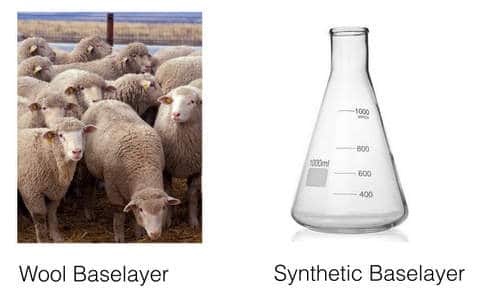
Wool vs synthetic baselayers: which is better? Wool baselayer garments feel warmer than synthetic baselayers, but synthetic baselayers dry more quickly than wool. What are the pros and cons of each and which should you buy for winter hiking, snowshoeing, or skiing?
The Role of a Baselayer
When dressing for vigorous winter activities, it’s best to use a layered clothing system consisting of a wicking baselayer that moves perspiration away from your skin, an insulating mid-layer that absorbs the perspiration but still holds in your body heat, and a waterproof/windproof shell layer that keeps external moisture or wind from cooling you.
The purpose of a baselayer top is to move perspiration generated while you’re active away from your skin so it won’t chill you. A good baselayer should have a close fit so it can effectively capture moisture, without any seams to chafe or irritate your skin. It takes extra energy to maintain your warmth if your skin is damp or wet, which is why you want a layering system that moves perspiration to your midlayer and out of contact with your skin. There the moisture can evaporate naturally without chilling you like a damp baselayer.
Synthetic Baselayers
If you sweat a lot when you’re active, go with a synthetic baselayer like Helly Hansen’s LIFA Striped Crew or REI’s Active Pursuits Long Sleeve Jersey which both have a fast-drying porous weave designed to rapidly transport perspiration from your skin up to your mid-layer.
This is critical. You don’t want wet or damp skin in winter, even if it’s buried under other layers of clothing because it will literally suck body heat out of you in an effort to dry itself. That’s how perspiration works. The body expels sweat and then tries to boil it off in order to cool itself. Instead, wicking baselayers move that sweat up to a midlayer garment that’s not in contact with your skin, so your skin stays dry while preventing you from being chilled.
While thin synthetic tops are not as insulating as wool, they’re quite durable and affordable, and you can wash and dry them a gazillion times without any special care. I have synthetic baselayers that have lasted 10+ years of constant use, while I’m lucky if I can get 2 years from ones made with wool, before they hole and disintegrate.
Wool Baselayers
If you run cold in winter and find yourself alternating between high activity and low activity levels (like downhill skiing), try might try a wool baselayer since it will feel warmer against your skin. Merino Wool baselayers are the softest, and we recommend the Minus33 Ticonderoga Lightweight Crew or the Smartwool Merino Classic Baselayer if you need a bit more warmth. However, we’d encourage you to stick with a thin wool baselayer rather than a midweight or heavy-weight one because it will wick better than a thicker baselayer garment, which just traps more moisture closer to your skin. If you still need more warmth, bulk up your midlayer insulation.
Synthetic Baselayer and Wool Midlayer
Can’t decide? Many people buy both wool and synthetic baselayers and switch between them depending on the activity and outside temperature. Others mix and match, going with a wicking synthetic baselayer and a wool mid-layer that doesn’t have to stay dry because its function is to stay warm when it absorbs perspiration passed to it from your baselayer. Personally, I prefer using a synthetic baselayer and a synthetic midlayer, since the latter can dry while I’m wearing it, as long as I take my shell jacket off and it’s exposed to the air.

Wool and Synthetic Blends
Still another option is to look at garments that blend wool and synthetic yarns. For instance, I had good luck with the Artilect Boulder 125 Crew which blends wool and synthetic materials to create a hybrid form of Merino wool, called Nuyarn, that is comfortable to wear and odor-resistant while being easier to care for and more durable than wool.
Which do you prefer? Wool or Synthetic?
SectionHiker is reader-supported. We independently research, test, and rate the best products. We only make money if you purchase a product through our affiliate links. Help us continue to test and write unsponsored and independent gear reviews, beginner FAQs, and free hiking guides.
